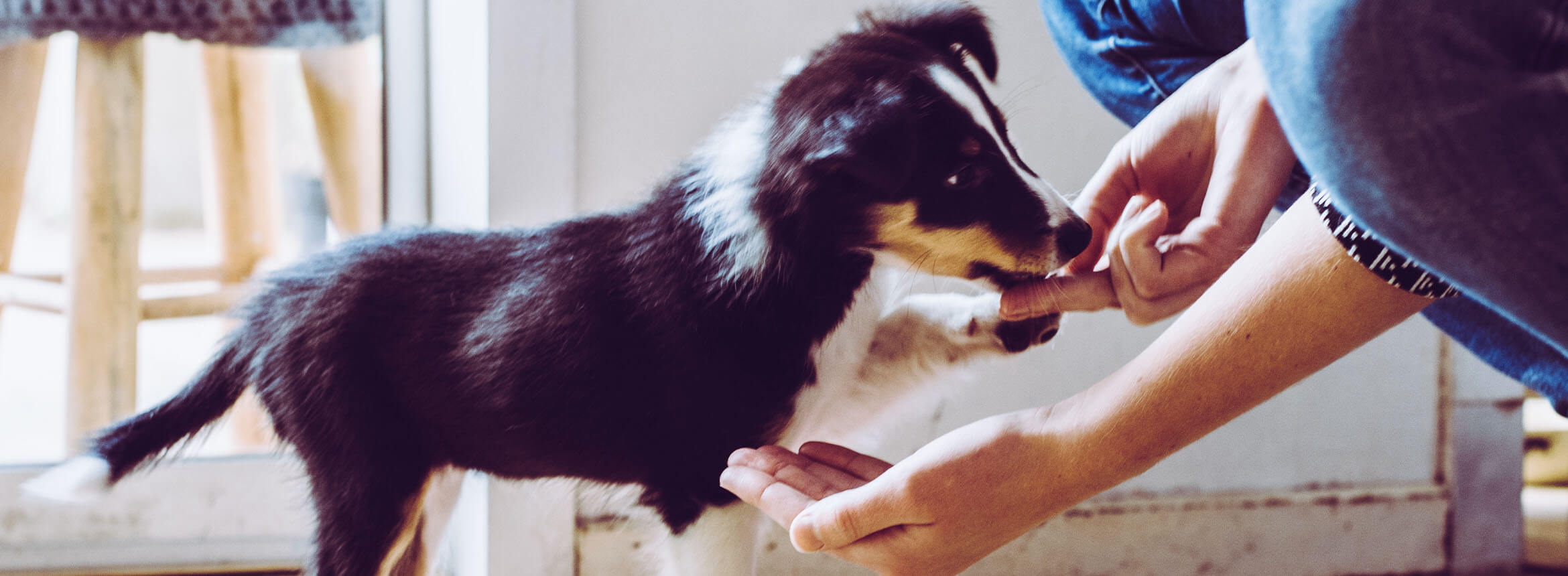Puppies are understandably excited when treats enter the picture, but their excitement doesn’t have to translate into you losing a finger. When taking treats, some pups are gentle of their own accord — but this isn’t innate behavior for dogs.
Treats can be an integral part of dog training — and learning to take a treat gently is a foundational skill. It will protect you and anyone else who offers your dog a treat in the future, including strangers.
Dog Training with Positive Reinforcement
The following “gentle” method will stop your puppy from nipping at your hand for treats. At the heart of this training is making dogs feel in control: If they behave a certain way (if they’re nice), they’ll get a treat (which is very nice).
Step 1: The Right Conditions
Your first goal is to create a sense of calm as this minimizes reactionary behavior from your buddy. Choose a spot that’s free of distractions, aim for a quiet time of day, and only attempt this training when your puppy is relaxed.
Step 2: The Initial Offer
Place a treat on your palm and close your hand into a fist. Direct your buddy to sit, which encourages calmness. Offer the treat. If your puppy bites your hand, maintain the fist, with the treat tucked tightly inside. Avoid jerking your hand away, as this could trigger predatory instincts like lunging and increasingly aggressive biting. This could also cause you to drop the treat, allowing your pup to nab it (and rewarding the bad behavior). Once the bites subside to licks or loving nibbles, praise your pal, open your hand, and allow your puppy to take the treat.
Step 3: Gentle Does It
Once your dog begins taking treats without biting, it’s time to add a cue word. Offer a treat inside your fist once again. When your pup reacts with licks or nibbles, say “gentle” right before you open your hand to release the treat. This establishes an association between the learned behavior and the cue word. Your pup will come to understand being gentle is the only way to get treats — and that obeying the “gentle” command will be rewarded.
Step 4: Treats in Sight
In this phase, hold a treat between your thumb and another finger. Offer the treat to your buddy and say “gentle.” If your puppy takes the treat gently, give praise. If your puppy lunges or is rough in any way, tuck the treat inside your fist and retract your hand. Repeat Step 3 until the desired behavior is mastered.
Step 5: Real-World Scenarios
Continue working on Step 4, but gradually incorporate distractions. For example, you could switch to a louder environment, bring another person into the room, or offer tastier treats. Increasing the variables helps to acclimate your pup so that, in time, your good boy or girl will take treats gently regardless of the circumstances.
Gradually Increase Treats to Motivate Your Puppy
Start training with a treat that’s tasty enough to get your puppy’s attention but isn’t their absolute favorite. If jerky sends them into a frenzy, try something milder, like a biscuit or a small piece of cheese. This helps prevent overexcitement that can lead to biting or jumping. As your pup becomes more confident and responsive during training, gradually offer more appealing treats to keep them motivated.
Use Puppy Training Cue Words
Many trainers use the word “gentle” when teaching puppies to take treats calmly, but the key is consistency — not the specific word. Choose a cue word or phrase that feels natural to you, and make sure everyone interacting with your puppy uses it consistently.
Protect Your Hands with Gloves
If your puppy tends to nip or bite when taking a treat, wearing gloves can be a smart precaution. Thin leather gloves offer enough protection to prevent scratches or bites without dulling your sense of touch. Thicker gloves, on the other hand, may keep you from feeling gentle nips —important signals that your pup still needs more training.
Keep Training Sessions Short
Short, focused sessions work best for your puppy’s limited attention span. Aim for about five minutes at a time to keep your pup engaged without causing frustration or fatigue.

